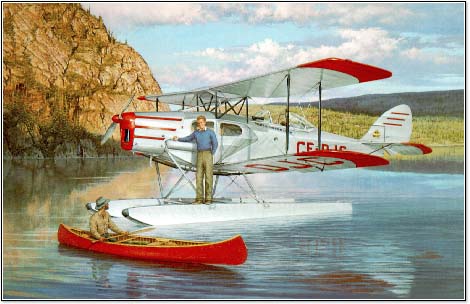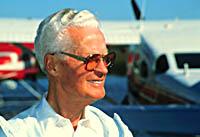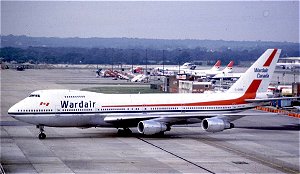
Biography
|
|
Nov. 22, 1921: |
Maxwell William Ward is
born in Edmonton. He grows up with stories of the early bush pilots - the
most exciting people in the world in his eyes. Not very interested in
school, Ward spends his later high school years counting the days until he
can join the air force to pursue his dream of flying. |
|
1940: |
Ward joins the Royal
Canadian Air Force. His first flight on an aircraft - as a passenger - is
commemorated with the loss of his "poise, courage and breakfast." His
airsickness isn't a one-time occurrence, but Ward doesn't let it deter him
from flying. |
|
Nov. 2, 1941: |
Ward gets his wings with
top marks. However, much to his disappointment, the high marks mean he will
be posted for instructor training - not as a fighter pilot overseas, as he
wanted. |
|
June 28, 1944: |
Ward marries Marjorie
Doretha Skelton - the woman he decided to marry upon first sight of her at
age 17. She was 16. |
|
1945: |
At the end of the Second
World War, Ward leaves the air force to pursue his dream of flying in the
bush, an area he'd never been to before. He joins Northern Flights
Limited. |
|
June 1946: |
Ward decides to strike
out on his own and forms Polaris Charter Company Limited. The plan is
to fly material for prospectors looking for gold into the mining camps
around Yellowknife. |
|
July 1946: |
Ward buys his first
aircraft, a single-engine biplane, a Fox Moth, for $10,000, with help from
family, friends and the bank. He crashes it on his first flight - taking it
back to Yellowknife. |
|
May 1947: |
Ward's troubles with the
Air Transport Board (ATB) begin. He's forced to shut down after being told
that he can't fly without a commercial license issued by the board. Ward
begins a partnership with another pilot and his airline Yellowknife
Airways. |
|
Oct. 1949: |
Ward packs up his
belongings and heads back to Alberta with his wife and children after a
series of misfortunes: his house burns down, his Fox Moth is destroyed (also
killing the pilot flying it at the time), and his partnership breaks down.
Ward decides that he just isn't cut out to be a bush pilot and sets out to
make a living building houses in Lethbridge. |
|
May 1951: |
Paying heed to "an
aching in [his] heart that would not stop," Ward heads back to Yellowknife
to be a pilot for Associated Airways. This time, he's determined not
to let any kind of hardships drive him out of the North again. |
|
Nov. 22, 1951: |
Crashes in the High
Arctic (Bathurst Inlet) during bad weather and spends five frigid days in
the cold before being rescued. |
|
July 1952: |
Ward applies to the ATB
for a charter license, determined to strike out on his own again. (When Ward
heard that his boss at Associated Airways wanted to promote him to manager,
Ward avoided him as he planned to start up his own business. As a result,
his boss fired him). |
|
May 1953: |
Ward gets unofficial
word that the ATB will approve his second application for a license. His
first one was turned down. |
|
June 1, 1953: |
Ward picks up his first
Otter at de Havilland. It costs him $100,000 - about two-and-half times the
cost of an average bush plane at the time. But, it is bigger, faster and can
carry a much heavier payload. Its distance range is 600 miles (966
kilometres), three times the range of Max's first Fox Moth. It is the first
de Havilland Otter to be used commercially in Western Canada and plays a
significant role in the development of the North as it can carry 4-by-8
sheets of plywood and 16 foot-long pieces of lumber. It could also easily
get into and out of lakes. Max chooses blue, with red and white trimming as
his airline's colours. |
|
June 3, 1953: |
Official approval of a
license for Wardair Limited. |
|
June 22, 1961: |
The company's name is
officially changed to Wardair Canada Ltd. to indicate its
international intentions. |
|
May 10, 1962: |
Wardair's first charter
passenger flight in southern Canada. The Alberta School Patrol Band is flown
from Calgary to Ottawa and back. |
|
June 22, 1962: |
Wardair's first overseas
charter from Edmonton to Copenhagen, Denmark. |
|
Apr. 28, 1966: |
Wardair takes delivery
of its first jet, a Boeing 727. It is the first Boeing jet sold in Canada. |
|
May 5, 1967: |
One of Wardair's pilots,
Don Braun, lands a Bristol freighter at the geographic North Pole. It
is the first wheel-equipped aircraft there. |
|
Sept. 18, 1967: |
Wardair goes public for
a much-needed injection of cash. |
|
Dec. 1967: |
Wardair starts inclusive
tours in the U.S. and package tours to Hawaii, the Bahamas and the
Caribbean. |
|
Mar. 25, 1968: |
The ATB sets new
regulations that all charter passengers on Wardair must be verified
to have been members of clubs for six months. (Wardair was under what was
called the Charter Affinity Rule, which dictated that charter flights could
only be sold to groups that could fill the capacity of the plane. Passengers
had to be a member of a club for at least six months.) This regulation does
not apply to scheduled airlines. |
|
May 10, 1968: |
Wardair buys a bigger
jet, a Boeing 707. |
|
May 1968: |
Wardair is expelled from
the Air Transport Association of Canada (which replaced the ATB) for not
abiding by its flying rules. Wardair is later asked to rejoin and is given
an honorary life membership in the association. |
|
Jan. 1, 1973: |
Charter Affinity Rule is
abolished. |
|
May 28, 1974: |
Ward is given the
Transportation Man of the Year Award for Alberta. In July, he is inducted
into the Aviation Hall of Fame. |
|
July 1, 1975: |
Ward is appointed an
Officer of the Order of Canada. |
|
June 10, 1976: |
Wardair Canada Ltd.'s
name is changed to Wardair International Ltd. |
|
Jan. 1, 1978: |
Deregulation comes into
effect in the U.S. |
|
Aug. 4, 1978: |
Ward writes Prime
Minister Pierre Trudeau to point out the inequities toward charter airlines
under the rules of Air Transport Association of Canada. By this time,
Wardair is Canada's third largest air carrier. |
|
Sept. 14, 1979: |
Ward is named the 1979
recipient of the Gordon R. McGregor Memorial Trophy for significant deeds in
commercial aviation - an irony as it was bestowed on behalf of McGregor, a
long-time president of Air Canada and Ward's "bitterest foe". |
|
Oct. 18, 1979: |
Wardair closes its
northern operations. |
|
Feb. 18, 1980: |
With Transport Minister
Don Mazankowski's urging to relax charter regulations, Wardair is allowed to
offer domestic charter air services. Wardair makes its first domestic
Advanced Booking Charter - Toronto to Vancouver a few months later. |
|
1980 - 1984: |
Wardair aggressively
expands its fleet of aircraft and builds a new workshop and hangar. |
|
Mar. 1985: |
Wardair is named the
world's top chartered airline by Holiday Which?, a British consumer
magazine. |
|
May 10, 1985: |
Wardair gets
international scheduled routes between Canada and the United Kingdom.
|
|
Mar. 20, 1986: |
Wardair gets a license
for a scheduled service within Canada. |
|
Mar. 1986: |
Holiday Which?
magazine honours Wardair again, this time with the distinction as the
world's finest scheduled carrier. This would be repeated the next year. |
|
1987 - 1988: |
Wardair goes on a buying
spree to meet the challenge of a scheduled service. It purchases twelve
airbuses and 16 McDonnell-Douglas MD-88s. |
|
Aug. 7, 1987: |
Canada passes
deregulation legislation, nine years after deregulation in the U.S. |
|
May 2, 1989: |
Wardair is sold to
Pacific Western Airlines (the company that owns Canadian Pacific) for about
$250 million. Ward and his family get $70 million from the deal.
Deregulation comes too late for Wardair. Behind in its reservation systems
and laden with heavy debt from the buying spree, Max decides to sell rather
than risk bankruptcy. 

|


